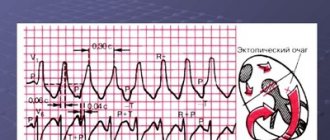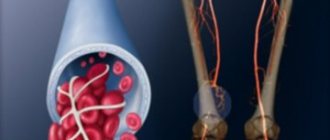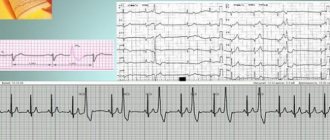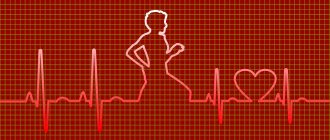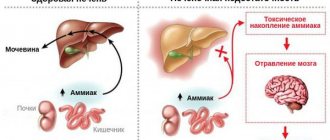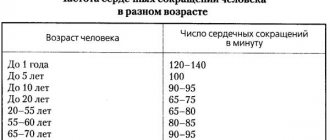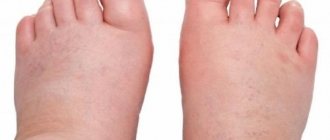Ventricular tachycardia (VT) is a type of paroxysmal tachycardia (link to page). It is characterized by disturbance of sinus rhythm and an increase in the number of ventricular contractions. The cause of the disease is changes in the heart muscle or the conduction system of the ventricles of the heart, as a result of which the re-entry mechanism (circular arrhythmia) is realized, or some of the heart cells begin to exhibit increased electrical activity, which leads to accelerated work of the ventricles of the heart.
During an attack, the heart rate (HR) ranges from 140 to 220 beats per minute. Among all arrhythmias, VT is the most dangerous, because it can transform into a life-threatening arrhythmia - ventricular fibrillation. In addition, during an attack the ventricles contract frequently, but not fully. This can lead to insufficient blood supply to the brain and cause loss of consciousness.
Description
Ventricular tachycardia is a pathological increase in heart rate caused by dysfunction of the right or left ventricles.
This condition is life-threatening and requires emergency hospitalization. The code in ICD-10 is I47.2. Ventricular cardiac arrhythmias, including ventricular tachycardia, are considered the most likely risk factors for sudden cardiac death. In 75-80% of fatal cases, ventricular fibrillation is diagnosed due to organic heart damage or genetic diseases.
Ventricular tachycardia can be reversible or chronic. In the first case, it is provoked by temporary factors: heat stroke, hypothermia, poisoning. The chronic form in 90% of cases develops in patients with structural cardiac diseases, such as myocardial infarction or myocarditis. A section of scar tissue is formed, which becomes a substrate for arrhythmic disorders. Often, ventricular tachycardia transforms into ventricular fibrillation - a period of chaotic and ineffective myocardial contraction, accompanied by cessation of blood circulation.
The causes of the development of ventricular tachycardia include:
- Cardiovascular diseases. Heart rhythm disturbances are diagnosed in patients with myocardial infarction, cardiomyopathy, heart disease, heart failure, and severe myocarditis.
- Poisoning of the body. Ventricular tachycardia sometimes develops due to alcohol intoxication, inhalation of glue vapors, and administration of narcotic substances.
- Traumatic heart damage. This reason is often found among athletes and military personnel.
- Administration of drugs. The cause of tachycardia can be the use of cardiac glycosides, antidepressants, fluoroquinols, flecainide and some other drugs.
- Hereditary and genetic heart diseases. Sometimes cardiac arrhythmias are the result of congenital anomalies of the organ. Example: Brugada syndrome.
When the cause of ventricular tachycardia cannot be established, we are talking about an idiopathic form of the pathology. As a rule, such disorders are chronic, but are not associated with life-threatening conditions.
The pathogenesis of ventricular tachycardia is varied and determined by its causes. The most common option is the presence of a factor that damages the myocardium (heart muscle). Foci of damage form in the ventricle, which alter the overall contractile activity of the organ. Paroxysms of ventricular tachycardia are formed, causing the heart to beat at a high frequency - more than 100 beats per minute. If the heart rate exceeds 200 beats/min, there is a high risk of sudden cardiac death.
Causes of ventricular tachycardia
In 98%, the cause of VT is a heart disease, in the remaining 2% the cause remains undetected. This pathology is called idiopathic.
Diseases that can lead to VT:
- myocardial infarction;
- post-infarction aneurysm;
- reperfusion arrhythmias;
- myocarditis;
- cardiosclerosis;
- cardiomyopathy;
- sarcoidosis;
- heart defects;
- genetic diseases
Let us note the provoking external factors influencing the development of VT:
- stressful situations;
- frequent psycho-emotional stress;
- increased physical activity;
- surgical intervention;
- drug overdose;
- hormonal imbalance in the body.
Symptoms
Photo: medicalinsider.ru
Short duration ventricular tachycardias with an increase in heart rate to 100-120 beats/min are often asymptomatic. They can only be determined by daily monitoring of heart rate. Some patients notice a rapid heartbeat within a few seconds if they are at rest, such as lying in bed before going to bed.
Sustained ventricular tachycardia lasts more than 30 seconds and is accompanied by the following symptoms:
- feeling of rapid heartbeat;
- interruptions and pauses in heart contraction;
- dizziness;
- weakness;
- dyspnea;
- pain in the heart area;
- loss of consciousness;
- fear of death.
What it is
Normally, the pacemaker of the heart, which sends impulses and regulates contractions of the heart muscle, is located in the sinus node.
From here, excitation passes through the fibers and ensures stable functioning of the heart. Sometimes this role is taken over by the structures of the conduction system located below - the atrioventricular junction (AV), the His bundle or the Purkinje fibers. Ventricular tachycardia manifests itself when the distal (end) part of this system (that which is below the AV node) becomes the pacemaker. If you want to know everything about tachycardia, we recommend watching the video below at the link. Causes, symptoms, diagnosis and signs that it’s time to see a doctor - talk about all this in 7 minutes. Enjoy watching!
Diagnostics
Photo: sante.by
A cardiologist examines patients with cardiac arrhythmias. Diagnostics is carried out comprehensively and includes the following methods:
- Collection of complaints and anamnesis data. Most patients who consult a doctor have characteristic symptoms of tachycardia: rapid heartbeat, chest pain, dizziness. The majority have a confirmed cardiac pathology, for example, a history of myocardial infarction.
- Physical examination. The palpation method determines the increase in heart rate from 100 to 220 beats per minute. The rhythm is often correct. A decrease in blood pressure is also characteristic.
- Laboratory methods. The results of a biochemical blood test indicate a decrease in the level of electrolytes: potassium, magnesium, calcium. For patients over 40 years of age, blood lipid levels and a coagulogram are recommended.
- Instrumental diagnostics. Gastric tachycardia is confirmed by electrocardiogram data. The chart has many features that can only be deciphered by a doctor. The most common features: wide QRS complexes (more than 0.12 seconds), dissociation of P waves and supraventricular “captures”, uniformity of QRS vectors (chest leads). Additional research methods are daily Holter ECG monitoring, exercise tests, ECHO-CG.
Prevention of ventricular tachycardia
When symptoms are detected, immediate diagnosis is important in order to eliminate the cause of the disease and treat it. In most cases, prevention is secondary and consists of preventing relapse. Therefore, an important part of prevention is regular examination of the cardiovascular system. Specialists of the Cardiology Center of the Federal Scientific and Clinical Center of the Federal Medical and Biological Agency conduct comprehensive heart checks; you can find out about the programs here.
To prevent the occurrence or recurrence of ventricular tachycardia, it is important to follow the doctor's recommendations and follow all his instructions.
Additional preventive measures include:
- regular blood pressure monitoring;
- body weight control;
- proper nutrition: exclude fatty, fried, spicy, salt;
- complete cessation of bad habits;
- exercise therapy and moderate physical activity.
Treatment
Photo: domdoctor.su
Therapy is carried out with the aim of completely eliminating or reducing by at least 50% attacks of ventricular tachycardia, as well as preventing sudden cardiac death. Treatment tactics are determined taking into account the severity of the pathology, the patient’s age, and the presence of concomitant diseases. The general direction of choice of treatment methods: from medication to surgery. There are three ways to help patients:
- Medication. Drug therapy is prescribed independently for mild forms of ventricular tachycardia, with a low risk of sudden cardiac death.
- RFA. Drug treatment can be replaced by intracardiac electrophysiological study and catheter radiofrequency ablation. This is a minimally invasive surgical procedure performed under local anesthesia. Catheters and special flexible electrodes are inserted into the patient through large veins to stimulate the heart and record its electrical activity. After the study, a “map” of the lesions is drawn up, and their targeted radiofrequency ablation is performed. The resulting scar does not conduct electrical impulses, so tachycardia no longer occurs.
- Surgical. If drug treatment and radiofrequency ablation are ineffective, a procedure for installing a cardioverter-defibrillator or other resynchronization therapy device with cardioversion/defibrillation functions is prescribed. The surgical intervention takes place under general anesthesia and requires compliance with all requirements of the pre- and postoperative period. As a result of this procedure, the frequency of tachycardia attacks in patients is reduced, and the risk of sudden cardiac death is almost completely eliminated.
A separate area of treatment for ventricular tachycardia is emergency medical care for a severe attack with cardiac arrest and circulatory arrest. The only effective way to restore heart function is to use defibrillators (electrical current delivery devices). Until the ambulance arrives, the patient must be kept alive with chest compressions.
The main signs of a severe attack of ventricular tachycardia are loss of consciousness, lack of breathing and pulse. It is necessary to lay the patient on his back on a hard, flat surface, strike him in the sternum with his fist and begin to apply intense, rhythmic pressure on the chest. The approximate frequency is 10 clicks per minute. Depth – 5-6 cm. Indirect cardiac massage should be carried out until the arrival of a medical team, since a person’s hands replace natural heart contractions and support blood movement. Emergency doctors restore heartbeats using a defibrillator and antiarrhythmic drugs.
ECG signs
Ventricular tachycardia is detected on an ECG as follows: dilated and deformed QRS complexes from 12 to 20 mm in length are recorded. The pulse is rapid, within 100-180 beats/min. Bradycardia below 99 or tachycardia above 200 beats/min are observed infrequently.
The ventricles may begin to contract faster due to instability of the source of excitation, blockade at the exit from the site of ectopia, periodic impulses from the sinus node, and with severe damage, the supraventricular rhythm is also activated. Atrial P waves are rarely detected, in approximately 30% of cases. A typical cardiogram of such a patient is shown in the photo.
Symptoms of ventricular tachycardia during prolonged paroxysm:
- loss of consciousness;
- epileptoid type seizures;
- dyspnea;
- pulmonary edema;
- collapse;
- shock.
After the rhythm is restored, post-tachycardia syndrome appears on the electrocardiogram for some time in the form of the appearance of a negative T wave and a decrease in ST below the isoline.
Medicines
Photo: zagranmaster.ru
The main group of medications used to treat ventricular tachycardia are antiarrhythmic drugs. Theoretically, class I, II and III drugs can be prescribed. However, extensive practical experience has made it possible to divide them into three orders of decreasing efficiency. First-line drugs include drugs that give a noticeable positive result in 70% of cases. An example of such a drug is Amiodarone. However, the list is not limited to them; the selection of the safest and most effective medicine is made by a doctor.
Self-treatment with antiarrhythmic drugs is strictly prohibited, as they can provoke adverse reactions, including death. Even for the safest drugs in this group, the frequency of undesirable effects ranges from 4-8% to 25-30%. It is worth starting treatment under constant monitoring of heart rate and under the supervision of a doctor.
Case from practice
A patient was brought to us with developed paroxysm of ventricular tachycardia. She complained of severe weakness and headache. According to the clinic doctor, the patient suffers from coronary heart disease with chronic heart failure; 5 years ago she suffered a large-focal heart attack. Objectively: pale skin, acrocyanosis (blue discoloration of fingers, lips), pulse 78 beats/min, rhythmic.
While the woman was in the hospital, an acute paroxysmal attack recorded on the ECG had to be stopped twice. She regularly took Sotalol and then switched to Bisoprolol. She was discharged with an improvement in her condition; it was recommended to follow a diet with limited salt and fatty foods, and constantly take Aspirin, Atorvastatin, and selective beta blockers.
Folk remedies
Photo: rusteaco.ru
For ventricular tachycardia, the use of traditional methods of treatment is possible as an addition to drug therapy prescribed by a doctor. Tinctures and herbal infusions will help reduce the heart rate, but do not forget that they act very gently, so they are used outside of exacerbations of the disease. The most popular plants are:
- Melissa. The tincture is taken 4 teaspoons per day, after diluting them with 50 ml of water.
- Elecampane. The roots of the plant are used to prepare the tincture. Dosage: 1 teaspoon 3 times a day 15 minutes before meals.
- Valerian. Chopped roots (1 tbsp) are poured with water and infused. Take 100 ml once a day.
The information is for reference only and is not a guide to action. Do not self-medicate. At the first symptoms of the disease, consult a doctor.
Reviews
Andrey
The state of health during attacks of paroxysmal tachycardia leaves much to be desired. and complications of the disease cause panic and overwhelming fear. It is important to diagnose the pathology in a timely manner in order to choose effective treatment. Thanks to the doctors of the clinic on Yauza for the quick and informative examination. Thanks to you, I avoided dangerous complications and managed to maintain my health.
Alexander
I was sincerely admired by the technical capabilities of the hospital. I never thought that one hospital could have so many different devices for detecting disease. The professionalism of the doctors also left the impression of no panic, no unnecessary movements. They quickly stopped the attack, ordered examinations, identified the cause and even selected treatment. I feel great only thanks to you.
Expert advice
Ventricular tachycardia is a dangerous condition. To reduce the likelihood of developing an acute attack, I would like to give the following recommendations:
- constantly take medications that normalize the rhythm and condition of the heart muscle;
- eliminate stressful situations;
- adhere to proper nutrition;
- engage in physical exercise within the age norm, but do not overload;
- exclude from the diet foods and drinks that can cause an increase in heart rate;
- do not use folk remedies as the only possible treatment option.

